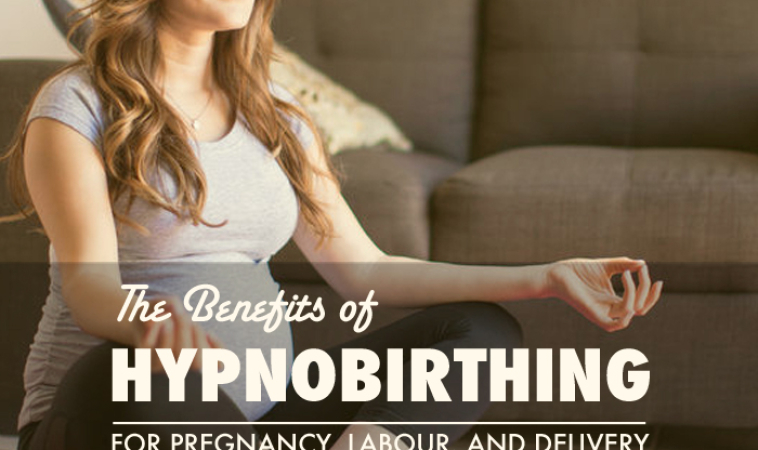I’ve recently noticed an increase in my expecting patients inquiring whether hypnobirthing is a safe and effective tool to aid labour and birth. When this was first presented to me, I admittedly knew very little about this topic and really couldn’t give an honest opinion. With the increasing popularity of this technique in the greater Toronto area and more patients asking for my advice, I had no choice but to become more knowledgable on this topic. I’d like to share my thoughts on this technique in this month’s article.
Hypnobirthing
Hypnobirthing is a mind-body technique that uses hypnosis in order to aid the birthing process. With research articles titled “Hypnosis: removing the labour from birth”, or “A dream birth, try hypnobirthing!” it is clear that hypnobirthing claims to reduce pain and discomfort during the labour and delivery.1,2 Hypnobirthing provides the women the ability to achieve a state of “hyper-consciousness” so she can dictate the way her body feels and handles labour and delivery. This method has been around for centuries and uses techniques in order to remove the pain from child-birth by reframing the mind to not fear the pain and potential for bad events that may occur during childbirth, but to understand childbirth this is a natural process your body is meant to do. Anxiety provoked by fear stimulates body to produce the natural “fight or flight” response – a primal response that has a cascade of effects in the body, including moving the blood from vital organs (ie the uterus) to the skeletal muscle in order to allow “fight” or “flight”. This depletion of blood from the uterus reduces the efficiency of labour, and increases contractile pain, making the labour much strenuous and burdensome. By training the brain to maintain a state of relaxation, women can prevent this fight-flight response and induce chemicals such as oxytocin, prostaglandins, and endorphins, meant to relax the smooth muscles (such as uterine muscles) promote a reduction of pain. Hypnobirthing for childbirth involves three parts: 1) preparation for delivery during pregnancy 2) inducing sustained and deep hypnosis or a state of relaxation during childbirth 3) presence of a supportive advocate.3
Preparation
The most important aspect of hypnobirthing is the preparation. This preparation involves reframing the mind towards positive thinking so not to think of labour as painful, long and frightening, but safe, easy and achievable. Studies have found the choice of words can influence the perception of pain in women going though labour process – the use of negative words increases the amount of pain.3 Changes words such as labour pains and contractions, to “uterine surges” and “waves” can promote developing positive attitudes towards the birthing process.
Reducing pain
The second part of hypnobirthing involves reducing pain of labour and delivery by teaching the woman how to enter a state of deep relaxation during labour. This involves refocusing the brain to believe the contractions are not painful and that this process is what her body is meant to do. Successful attempts produce pain-free outcomes by inducing a state of relaxation, allowing for the natural release of pain-relieving endorphins. Benefits extend to avoiding the use of pharmaceutical medications during labour. The third component involves having someone there mediating the birth towards mother’s wishes so she does not need leave the hypnotic state. Having this security will allow the mom to feel confident about staying in this state without the worry of events not falling inline with her birthing plan.
There have been studies on hypnobirthing but the outcomes are mixed – some finding it’s helpful, some finding it’s not. It is noted that it is difficult to perform quality studies on this topic. Limitations mainly involve low patient numbers, and the lack of standardized techniques of hypnobirthing – there are a number of different techniques implemented by different trainers.3 However this technique remains promising and the number of expecting mothers who have recently been enamoured by this technique may pave ways for increased populations needed for supportive research.
Hypnobirthing is a non-invasive, safe technique used to help an expecting mother reframe her mindset and attitude towards labour and delivery. Despite the lack of studies demonstrating clear efficacy of this technique, I feel the idea of training the body to relax and view labour and delivery as a positive, innate and natural process can benefit a pregnancy in many ways. Often I see in my practice women feeling anxious about things that may or may not go wrong her their pregnancy – this increased levels of stress and anxiety can contribute to other complications such as high blood pressure, stress eating, anxiety, and depression. I feel that teaching expecting moms how to achieve positive attitudes towards their pregnancy can benefit the pregnancy in many ways, including reducing pain during labour and delivery.
 Dr. Tanya Lee, N.D. received her Honours Bachelor of Science degree in Biochemistry and Biomedical Sciences from McMaster University, and was trained as a Naturopathic Doctor at the Canadian College of Naturopathic Medicine. Dr Lee practices full-time between two clinics located in Toronto and Milton Ontario and has been voted Milton’s favourite Naturopath in 2013 and 2014. Her primary care practice focuses on family medicine, treating a wide variety of conditions such as hormonal (endocrine) disorders, fertility, digestive problems, cardiovascular disease, diabetes, insomnia and fatigue. She has a special interest in the treatment of autoimmune diseases, paediatric and perinatal health. Tanya offers her clinical knowledge to a number of publications, including the Natural Path.
Dr. Tanya Lee, N.D. received her Honours Bachelor of Science degree in Biochemistry and Biomedical Sciences from McMaster University, and was trained as a Naturopathic Doctor at the Canadian College of Naturopathic Medicine. Dr Lee practices full-time between two clinics located in Toronto and Milton Ontario and has been voted Milton’s favourite Naturopath in 2013 and 2014. Her primary care practice focuses on family medicine, treating a wide variety of conditions such as hormonal (endocrine) disorders, fertility, digestive problems, cardiovascular disease, diabetes, insomnia and fatigue. She has a special interest in the treatment of autoimmune diseases, paediatric and perinatal health. Tanya offers her clinical knowledge to a number of publications, including the Natural Path.
References:
- Mottershead N1. Hypnosis: removing the labour from birth. Pract Midwife. 2006 Mar;9(3):26-7, 29.
- Graves K. A dream birth? Try hypnobirthing! Pract Midwife. 2013 Sep;16(8):S13-4.
- Beebe KR. Hypnotherapy for labor and birth. Nurs Womens Health. 2014 Feb-Mar;18(1):48-58; quiz 59. doi: 10.1111/1751-486X.12093.

















